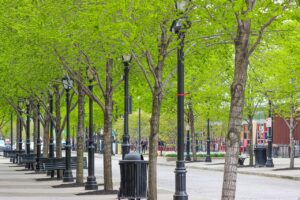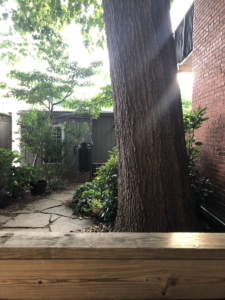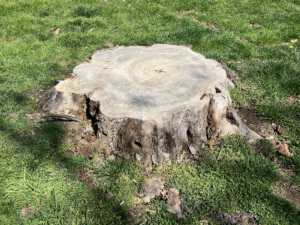For the Love of Trees

The summer heat has set in. In fact, it’s been some of the most extreme heat the planet has ever seen. As the temperatures rise, so does my concern for our urban trees. Drought and heat stress from climate change is a major driver of urban tree loss. And the death of those trees exacerbates urban heat.
The cooling effect of trees is well known and significant. Their shade can cool surfaces by an incredible 20-45 degrees fahrenheit, and reduce air conditioning demand by 20-30%. Not only that, trees also provide flood control by absorbing rainwater and slowing runoff.
The positive benefits of trees, however, are not shared equally. Disinvestment in many Black and brown neighborhoods has led to the loss of urban trees and the emergence of dangerous heat islands.
The plight of urban trees hits close to home for me. Literally. My postage-stamp-sized backyard in Washington DC hosts one of the most spectacular trees in the neighborhood. A massive Red Oak, 36 inches across at the base, stretches its branches over not only my home, but four of my neighbors’, providing shade and relief during DC’s notoriously muggy summers. I have measured a 20 degree difference between its shade and the parking area in the alley, and I’ve developed a strong affection for everything it provides.

But the tree is under strain. I noticed unhealthy branches and thinning in the upper canopy during the first summer after moving in. An arborist explained that it’s difficult for urban trees to get the water and nutrients they need with so much concrete and paved surfaces, and climate change is making that difficult situation so much worse. A tree surgeon removed the struggling branches and applied fertilizer to boost the tree’s chances. But not long after, I discovered the signs of further distress. The tree had come under attack by wood-boring insects and a fungus. A tell-tale sign, I was told, that it was losing its battle with a hostile climate. Stressed trees have weakened defenses and attract these pests, which are usually the cause of their ultimate demise.
I’m in an ongoing (and expensive!) struggle to nurse my distressed oak back to health. I’ve had treatments applied to control the pests, I give it compost to restore soil nutrients, I water it with rain captured in my rain barrel, and I’ve had more diseased branches removed. I’m doing everything I can …seriously, I even hug it from time to time.
While the tree is the one struggling, I feel a great deal of distress myself. The grief and worry is sometimes intense, perhaps excessive at times, but there’s something powerful about such an old and magnificent tree. It’s hard to bear the thought that it might not survive.
At the onset of my third summer caring for this tree, there are hopeful signs that the treatments I’ve applied and the attention I’ve been giving it are starting to have an effect; there are currently no signs that disease is spreading to the lower canopy. We are hoping for the best! But, it’s hard to have the same optimism about other trees in the city. It seems like every time I go for a walk, there’s another stump and a patch of sun-baked ground.

My request to you is this: let’s start thinking of trees as more than just decorative extras or “nice to have”. Let’s see them as they are, as critical infrastructure that will keep us cool in extreme heat conditions. We need to make sure our neighbors and our local leaders understand this, so please, talk to them about the benefits trees provide. Explain that it takes a lot to keep trees alive, and it will take even more as climate change progresses. Advocate for the expansion of urban tree cover, especially in parts of the city that are already lacking. And most of all, nurture them. Their survival – and potentially ours – depends on it.
About the Author
Brett Matulis, Communities Program Director, ecoAmerica
Additional Resources
American Climate Leadership Awards 2023 Broadcast Recording
ecoAmerica American Climate Leadership Awards Replication Guides
